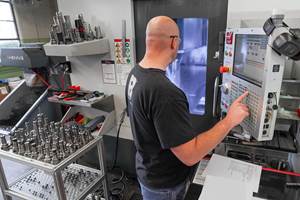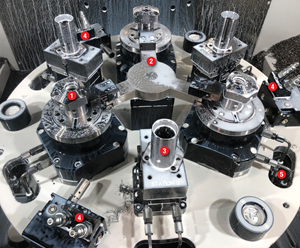Securing The Future
Multiple-part fixturing helps boost the output of these high-volume machining cells while preserving flexibility. The success of these cells is proving to be a critical component of this automotive part maker’s turnaround strategy.
Share







Autodesk, Inc.
Featured Content
View More
Less than 3 years ago, General Automotive Manufacturing, LLC (Franklin, Wisconsin), a manufacturer of precision automotive fuel injection and hydraulic parts located in the Milwaukee area, was in trouble. It was having difficulty making delivery dates, scrap rates were high, and labor and tooling costs were excessive. Making matters worse, orders for precision machined automotive parts were down industry-wide because of the recession. In a tailspin, the firm closed one of its two plants, also located in Franklin, and laid off more than 25 percent of its workforce.
The company had recently been acquired by Mason Wells Inc., a Milwaukee-based private equity firm. To halt General Automotive’s slide, Mason Wells brought in Jim Mitchell, a consultant with a successful track record of turning around troubled manufacturing firms, and soon appointed him CEO of the company.
Mr. Mitchell and his management team not only stopped General Automotive’s slide but also engineered an amazing turnaround in its fortunes. The company is projecting a 25 percent increase in sales in 2004, following a 60 percent increase in sales last year. It has greatly expanded its workforce (to about 400) and is looking for additional qualified personnel to staff a new $1.5-million, 45,000-square-foot expansion being added to its existing 110,000-square-foot facility.
Multiple Strategies
Mr. Mitchell employed multiple strategies to achieve General Automotive’s turnaround. The first item on the agenda was changing the “culture” of the company. Next, counterproductive layers of plant management were peeled away. Then came a program aimed at getting employees to show more initiative and take more responsibility. The company even instituted a new bonus program in which the entire workforce participates. The people strategies are described in more detail in the sidebar on page 80.
There is also a hardware strategy—a major equipment modernization program designed to make the company’s production operation more competitive. “A long-term differentiator in this industry is investing in the production process,” Mr. Mitchell stresses. “Those who don’t invest in the process will die. Those who modernize their production operations wisely will be the winners. That, in a nutshell, is what we’ve been doing. Over the last 2 ½ years, General Automotive has invested about $9 million in modern CNC machine tools and related equipment.”
In the past, General Automotive produced parts on a variety of conventional stand-alone machine tools, moving the parts from one type of machine tool to another as dictated by machining requirements. The process was highly flexible, but movement of the parts through the plant was slow and labor-intensive, and it created numerous possibilities for error.
General Automotive makes about 150 different parts, most of which are in production at any given time. Up to 80 percent of its production involves long-running jobs that fall into two groups: fuel injector bodies and smaller fuel injector components, such as tappets and adapters. The balance is short-run jobs and prototype work. To handle the three different types of work efficiently, the company divided its facility into three separate business units.
High-Volume Machining Cells
For the long-running, high-volume jobs, the company created machining cells dedicated to producing one part or a family of parts. Most of the cells have several identical machines (usually CNC turning centers and/or machining centers), with the number depending on the needed production volume. For example, the cell shown on pages 76 and 77, assembled to machine injector bodies, includes three Nakamura-Tome TW 20 CNC twin-spindle lathes and four Mori Seiki 400-Series horizontal machining centers.
The injector body starts out as a Y-shaped steel forging that General Automotive purchases on the outside. The first operation is turning of the OD and ID on one of the twin-spindle CNC lathes. Securing the unbalanced, non-symmetrical forging for machining necessitated special chucks and jaws, which are provided by Waukesha Machine & Tool Co. (Waukesha, Wisconsin), a Milwaukee-area distributor of Buck chucks. All OD operations are performed with the part held in the front spindle, and all ID operations are performed with the part held in the back spindle. The part is completely turned in one CNC lathe. All three lathes in the cell perform the same turning operations.
After the part is turned, it is transferred to one of the cell’s four horizontal machining centers for various hole-making operations. (In order to minimize part cycle times, no live-tooling operations are performed on the lathes. All drilling, tapping, milling and similar operations—except one—are performed on the machining centers.) As in the case of the lathes, each machining center performs the same operations.
Each HMC is equipped with a special tombstone fixture that holds 24 injector bodies at a time for machining. The fixtures are produced by the Engineered Tooling Division of Busche Enterprise (Albion, Indiana) from a design supplied by General Automotive. The fixture has three “zones,” each of which holds the parts in a different position for machining. It indexes twice in the machining cycle to present three different faces of the injector bodies to the spindle for machining.
At the end of a machining cycle, the pallet holding the tombstone fixture rotates out of the machining area to the load/unload position. Here, the operator removes the completely machined injector bodies from the fixture’s final zone, advances the remaining injector bodies to the next zone (A to B and B to C) and loads a new batch of parts in the fixture’s first (A) zone. A completely machined set of parts is unloaded at the end of each machining cycle. No machining time is lost, because the unloading/repositioning/loading of parts takes place on the “idle” fixture while parts on the “working” fixture are being machined.
The three-zone tombstone fixture is an improvement over the original machining process developed by the customer, which used two different fixtures. The fixtures were originally designed for use on vertical machining centers. General Automotive redesigned the fixture to take advantage of the larger machining envelope of its horizontal machining centers, consolidating the functions of the two original fixtures into a single fixture. The improvement not only reduced the number of times that the injector bodies must be repositioned for machining, but it also increased the number of finished parts per machining cycle.
The machined injector bodies go from the machining centers to a three-spindle gundrill (included in the cell to further reduce cycle time). From there, the parts go through an electrochemical milling (ECM) or electrochemical deburring (ECD) process to chemically remove any burrs inside the fuel passages. (About one-third of General Automotive’s parts are fuel injection components, all of which go through chemical deburring. The deburring operation is critical for high-performance fuel injection components.) After deburring, the parts are washed, packed and shipped to the customer.
Second Cell
A second cell is dedicated to high-volume production of a smaller cylindrical part called a fuel injector adapter. The adapters are machined from blanks produced on lathes elsewhere in the plant; however, future plans include incorporating the lathes in the cell.
As with the cell described earlier, the fuel injector adapter cell is made up of several identical machine tools—in this case, Brother Model TC-32A vertical machining centers—performing identical operations to produce the required part volume. Another similarity to the previous cell is that each machine is tooled for multiple-part machining. In this case, each of the VCMs is equipped with a Tilt Rotary MultiDex 360 multi-collet fixture with fourth- and fifth-axis positioning capability, made by Beere Precision Products (Racine, Wisconsin). The fixture is capable of holding four round parts at a time for machining.
According to Beere, indexers that install on the worktable of a VMC are usually too large to accommodate more than one or two parts at a time for machining. This limitation restricts the throughput of the machine tool and ties the operator to the machine because of the frequency with which he or she must load/unload parts. The Beere indexer uses standard 5C collets spaced on 2 ½-inch centers to hold up to four parts at a time for machining.
For General Automotive, that means being able to produce four parts per machining cycle instead of one or two, and the longer machining cycle enables the operator to tend more than one machine. In the first operation, after the blanks are machined on one end, the fixture tilts to permit a hole to be drilled in the side of each part at a 7-degree angle to its main axis. The blanks are unloaded from the first VMCs, turned over and loaded in additional VMCs tooled to machine the back end.
After the parts are completely machined, they go from the cell to the plant’s ECD equipment for deburring, then to an outside vendor for heat treating. When the parts come back from heat treat, they go through a lapping operation to bring them within specs for size and parallelism.
The adapter cell has nine machines and is staffed by four operators. Much of the operators’ time is taken up with loading and unloading. To give them more time to handle other responsibilities, automated load/unload equipment will be added to the cell.
They’re Back
In a period when many manufacturing firms are still mired in recession, General Automotive has come roaring back. Many of the customers that went away when things looked bleak have been won back, and some important new customers have come on board. Much of the new business involves components for new fuel injection systems developed to meet EPA-imposed emission standards on diesel engines.
“A little over a year ago, we had one machining center,” Mr. Mitchell notes. “Today, we have 25. General Automotive will almost certainly continue to move in the direction of flexible, more productive machine tools, machining cells that can be fine-tuned to efficiently produce one product and then reconfigured quickly to produce a different product just as efficiently, and workholding arrangements that permit us to set up multiple parts at a time for machining instead of one at a time. On a people level, we’re cultivating a genuine concern among our employees about satisfying our customers’ needs. We’re encouraging our employees to participate in a cultural movement that says we’re all part of the problem; [we’re] all part of the solution; and together, we can make it happen.
“All of that effort is driving us into the high added-value domain, precision machining, high on-time delivery, low scrap, low variability, six sigma thinking . . . which has enabled us to differentiate ourselves. Our customers understand and appreciate what we are doing, because many of them are going through the same process.”
Most CEOs talk a good game, but Mr. Mitchell can point to the fact that General Automotive’s sales pace nearly doubled during the last 2 years. Also, much of the new capacity represented by the plant expansion is already committed to new jobs.
To contact General Automotive Manufacturing, call (414) 423-6400.
To contact Waukesha Machine & Tool, call (262) 542-7689.
Related Content
Custom Workholding Principles to Live By
Workholding solutions can take on infinite forms and all would be correct to some degree. Follow these tips to help optimize custom workholding solutions.
Read MoreMedical Shop Performs Lights-Out Production in Five-Axes
Moving to five-axis machining enabled this shop to dramatically reduce setup time and increase lights-out capacity, but success relied on the right combination of workholding and automation.
Read MoreFixturing Castings Made Simple Through Adhesive Workholding
When a casting proved too malleable for traditional gripping, Thomas/Euclid Industries adopted — and succeeded with — Blue Photon adhesive workholding.
Read MoreMachining Vektek Hydraulic Swing Clamp Bodies Using Royal Products Collet Fixtures
A study in repeatable and flexible workholding by one OEM for another.
Read MoreRead Next
5 Rules of Thumb for Buying CNC Machine Tools
Use these tips to carefully plan your machine tool purchases and to avoid regretting your decision later.
Read MoreBuilding Out a Foundation for Student Machinists
Autodesk and Haas have teamed up to produce an introductory course for students that covers the basics of CAD, CAM and CNC while providing them with a portfolio part.
Read MoreRegistration Now Open for the Precision Machining Technology Show (PMTS) 2025
The precision machining industry’s premier event returns to Cleveland, OH, April 1-3.
Read More


























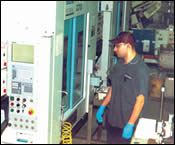
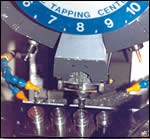
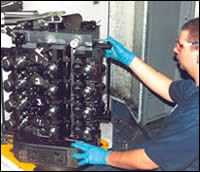
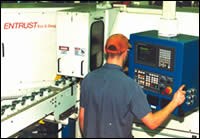
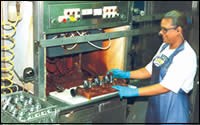
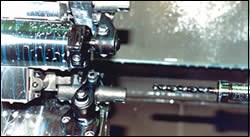
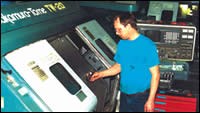








.jpg;maxWidth=300;quality=90)



